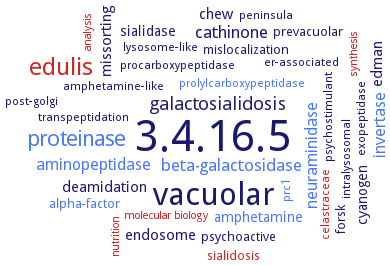3.4.16.5: carboxypeptidase C
This is an abbreviated version!
For detailed information about carboxypeptidase C, go to the full flat file.

Word Map on EC 3.4.16.5 
-
3.4.16.5
-
vacuolar
-
edulis
-
proteinase
-
galactosialidosis
-
beta-galactosidase
-
cathinone
-
invertase
-
aminopeptidase
-
neuraminidase
-
edman
-
deamidation
-
missorting
-
chew
-
endosome
-
cyanogen
-
amphetamine
-
sialidase
-
prevacuolar
-
forsk
-
alpha-factor
-
mislocalization
-
sialidosis
-
psychoactive
-
psychostimulant
-
transpeptidation
-
er-associated
-
prolylcarboxypeptidase
-
exopeptidase
-
amphetamine-like
-
post-golgi
-
lysosome-like
-
intralysosomal
-
prc1
-
procarboxypeptidase
-
celastraceae
-
peninsula
-
analysis
-
synthesis
-
nutrition
-
molecular biology
- 3.4.16.5
- vacuolar
- edulis
- proteinase
-
galactosialidosis
- beta-galactosidase
-
cathinone
- invertase
- aminopeptidase
- neuraminidase
-
edman
-
deamidation
-
missorting
-
chew
-
endosome
-
cyanogen
- amphetamine
- sialidase
-
prevacuolar
-
forsk
- alpha-factor
-
mislocalization
- sialidosis
-
psychoactive
-
psychostimulant
-
transpeptidation
-
er-associated
- prolylcarboxypeptidase
-
exopeptidase
-
amphetamine-like
-
post-golgi
-
lysosome-like
-
intralysosomal
- prc1
-
procarboxypeptidase
- celastraceae
-
peninsula
- analysis
- synthesis
- nutrition
- molecular biology
Reaction
release of a C-terminal amino acid with broad specificity =
Synonyms
A-type metallocarboxypeptidase, acidic serine carboxypeptidase, AtCPY, BRS1, carboxypeptidase a, carboxypeptidase A4, carboxypeptidase C, Carboxypeptidase II, carboxypeptidase Y, carboxypeptidase YSCY, carboxypeptidase-Y, Case, CatA, CathA, cathepsin A, CaY, CP-MI, CP-MIII, CP-WIII, CPA4, CPase, CPC, CPD-Y, CPW, CPY, Cpy1p, CTSA, Cxp1, deamidase, EC 3.4.12.1, EC 3.4.16.1, EC 3.4.16.3, hCath A, HPP, lysosomal carboxypeptidase A, lysosomal protective protein, MO54, More, MpiCP-1, MpiCP-2, Phaseolin, PpcA, PRC1, proCPY, protective protein cathepsin A, protective protein/cathepsin A, retinoid-inducible serine carboxypeptidase, SCP, Scpep1, Ser carboxypeptidase, Ser carboxypeptidase-like protein, serine carboxypeptidase, serine carboxypeptidase 1, serine carboxypeptidase I, serine carboxypeptidase Scpep1, SmSCP-1, TcCBP


 results (
results ( results (
results ( top
top





